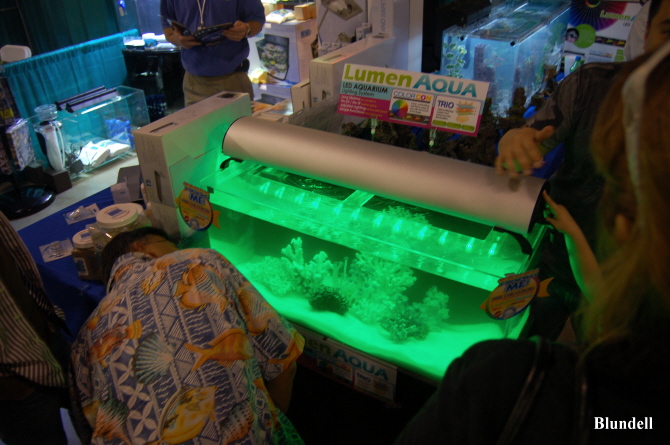
For years and years we’ve seen a hobby dominated by white lights, with blue actinics. Be it halide, pc, vho, led, or anything else; the usage of a bright white light with the enhancement of blue light (about 420 to 450nm) has been the staple of this hobby. The idea of running the actinics earlier in the morning and later at night, for a blue glow of “sunrise” and “sunset” has been the norm for well over a decade. The use of blue light to serve as an actinic source has been well known and well documented. What about other actinic lights? Maybe the hobby has been so caught up in the status quo that we’ve completely missed out on what could be the next big thing… GREEN!
If you were to do a search for green aquarium lights you’d find many hits for the other form of green, the practice of environmental responsibility. Green lighting is almost always thought of low energy, high efficiency lighting usage (such as led fixtures, water clarity, aquarium depth, reflectors, etc). What I want to do in this article is to introduce the readers to the concept of using green light! Green light can be a tool used to get brilliant colors from corals. As you see in the picture above, some light fixtures are now equiped with green lights. Some of the corals in your tank get their amazing colors due in part to the green light they receive. This green light can stimulate many proteins (namely DsRed fluorescent protein) to produce an array of potential colors. The most common color produced by this fluorescence that I’ve found is the red and some red-orange.
Shown here are a couple of examples of corals that exhibit red fluorescent emission energy when given a green source of excitation energy. The enhanced colors seen on these corals when placed in aquariums, is due in part to the green light they are receiving. Light of about 510nm (green) will cause some proteins to emit light at around 584nm (yellow-orange) and 650nm (red). With this particular protein the red fluorescence can be about 100 times more powerful than the green fluorescence when excited by a standard 480nm blue light source.
Green light has not been shown to produce biological effects in terms of energy usage and growth. In other words the coral may not be getting anything useful from this light and it may not help the coral grow in any way. However, green light does produce a biological effect in terms of color. Using green light is completely for aesthetics at this point.





Adding green light to your tank may be one step in increasing the aesthetics and the fluorescent colors. The actinic effects of green light are still not known. Currently, this type of effect is still very small compared to the effects of blue light, but documented here is evidence for further investigation.
Special thanks- Charlie Mazel for his ground breaking work and continued support, Glen Mansker for his technical help and services, and Brad Syphus along with the WMAS for allowing us the opportunity to educate other hobbyists.
Blundell, A. (2010), “Going Green With Lights- not total energy usage, but as excitation fluorescent energy”, ReefBuilders.



